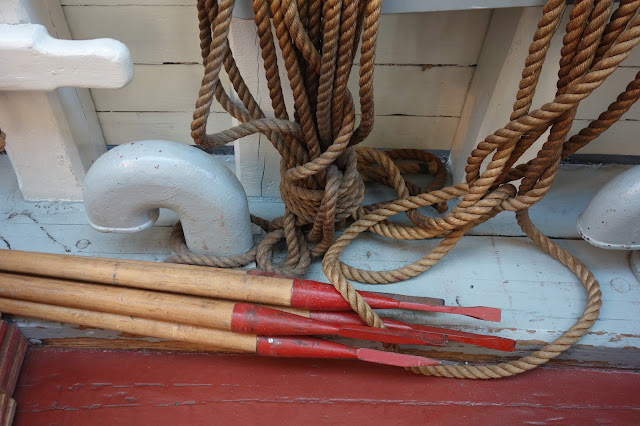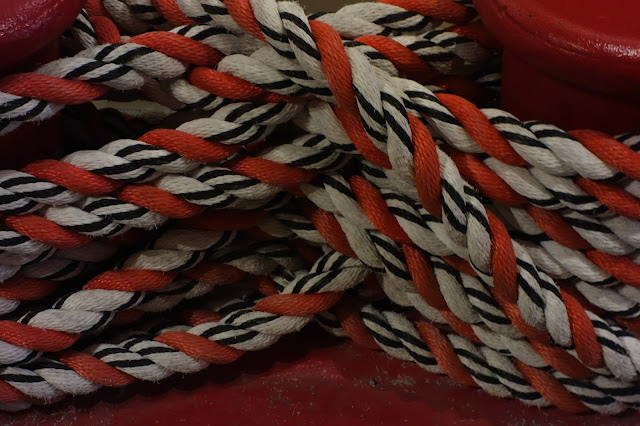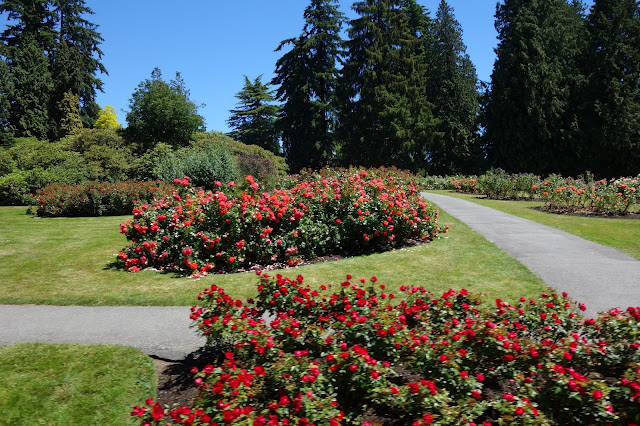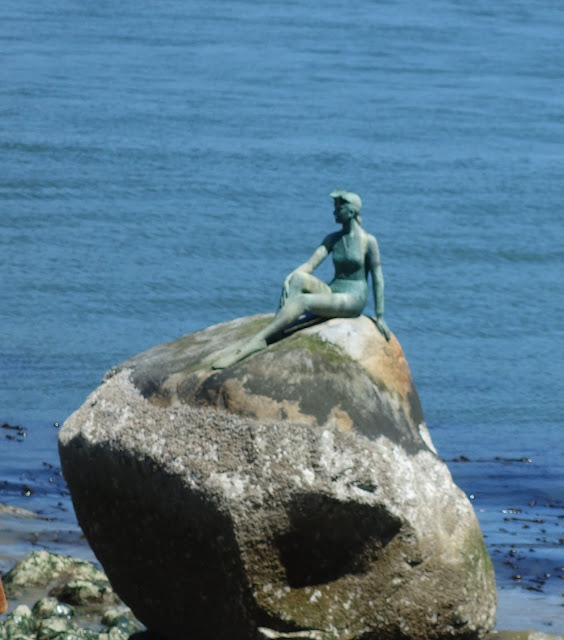the dragging noodles were good-
scallion pancake is better in our regular Chicago places - Ed's Potsticker and Lao Sze Chuan-
soup dumplings too thick and gummy-
potstickers decent but overall not a stellar Chinese food place despite some good reviews-
we made plans for the following day and by this time my ear infection was causing full on vertigo so we were somewhat limited as I could only walk with the assistance of a stick. We started out at the maritime museum and enjoyed the exhibits about the ice-breaker ships that sailed through the northwest passage.
the first thing I learned at the museum was even before we got inside- I found out that the Yellow Submarine - which I had always thought of as a cartoon submarine was actually a real one- the strange bulbous shape was not just an affectation of the artist but based on a real submarine - who knew??? LOL I always thought the submarines looked like the ones on TV or in the movies and they never looked like this or the Yellow Submarine...
Then we went inside and learned many things about the attempts to get across north Canada on the water - from the Pacific to the Atlantic--- and the arctic supply ship the St Roch...
here is info from the website about this exhibit- Built in British Columbia, named after a parish in Quebec, captained by a Norwegian immigrant, crewed by farm boys from across the country, and helped by the Inuit, the St. Roch was the first vessel to sail the Northwest Passage from west to east (1940-1942), the first to complete the passage in one season (1944), and the first to circumnavigate North America.
One of the only ships in service in the Arctic in the early part of the 20th century, the St. Roch is made of an unusual design of thick Douglas Fir planks reinforced with heavy beams to withstand the ice pressure and an outer shell made of some of the hardest wood in the world, Australian Eucalyptus 'iron bark'.
Between 1928 and 1954, St. Roch logged tens of thousands of miles crossing and re-crossing the Arctic, acting as a floating detachment of the RCMP in the North. At various times a supply ship, a patrol vessel and a transport, the St. Roch was the only link between the various scattered northern communities. Yet it had not yet accomplished the feat for which it would become famous. For many years, it had been the dream of Captain Henry Larsen to cross the Northwest Passage, just as Amundsen had done for the first time in the Goja in 1903. But time and time again, the dream had to remain a dream.
Finally, with the outbreak of the Second World War and the Nazi invasion of Denmark (Greenland), the opportunity presented itself. Launched on its famous voyage on a secret mission to cross the Arctic during the war, this amazing vessel traveled through treacherous and uncharted waters to cross the Northwest Passage and the High Arctic, with only a small crew of steadfast men who had just their skill, talent and no small amount of luck to rely on. Incredibly, they managed to make the crossing not just once, but twice, and in only 86 days the second time!
Now, you can explore one of the world's great Arctic explorers and a National Historic Site of Canada. Walk the decks, tour the interior cabins, marvel at the "ice-bucket", wonder at the close-knit quarters, and even take the helm to traverse uncharted waters just like the brave men of 1942/44.
The views of the St Roch from outside the ship-
an exhibit lets you try to steer the ship through the ice fields - LOL harder than you might think - they don't just float away when you hit them...LOL
Captain Beckett maneuvers his craft through dangerous waters LOL
after an informative video of about 15 minutes we go aboard the St Roch-
in the front - below deck where sailors bunked-
on deck "first nations" people lived in tents- not going there- this seems too horrible to me but maybe others didn't find it so discriminatory-
then we toured the main quarters for the officers - a whole different story of course-
then on to the rest of the museum where there were a number of other interesting exhibits-
then we waited outside for the HOHO bus (for those of you not familiar with the term - it stands for hop on hop off and they usually are a good way to get the lay of the land and scout out things you might want to spend more time (if you have it) visiting....
from wikipedia - about Vancouver- some of these things we learned on the HOHO bus-
The Greater Vancouver area of around 2.4 million inhabitants is the third most populous metropolitan area in the country, the second largest city on the United States–Canada border, and the most populous in Western Canada. Vancouver is one of the most ethnically and linguistically diverse cities in Canada; 52% of its residents have a first language other than English. Vancouver is classed as a Beta global city. The City of Vancouver encompasses a land area of about 114 square km, giving it a population density of about 13,590 per square mile. Vancouver is the most densely populated Canadian municipality with over 250,000 residents, and the fourth most densely populated such city in North America behind New York City, San Francisco, and Mexico City.
The original settlement, named Gastown, grew up on clear cuts on the west edge of the Hastings Mill logging sawmill's property, where a makeshift tavern had been set up on a plank between two stumps and the proprietor, Gassy Jack, persuaded the curious mill workers to build him a tavern, on 1 July 1867. From that first enterprise, other stores and some hotels quickly appeared along the waterfront to the west. Gastown became formally laid out as a registered town site dubbed Granville, "Burrard Inlet". As part of the land and political deal whereby the area of the town site was made the railhead of the CPR, it was renamed "Vancouver" and incorporated shortly thereafter as a city, in 1886.
By 1887, the transcontinental railway was extended to the city to take advantage of its large natural seaport, which soon became a vital link in a trade route between the Orient, Eastern Canada, and Europe. While forestry remains its largest industry, Vancouver is well known as an urban centre surrounded by nature, making tourism its second-largest industry. Major film production studios in Vancouver and Burnaby have turned Greater Vancouver and nearby areas into one of the largest film production centres in North America, earning it the film industry nickname, Hollywood North.
the influx of immigrants surrounding the 1997 transfer of Hong Kong from British control to Chinese created a city of high rises and high density - sometimes nicknamed Hong-Couver. The diversity gives Vancouver a "flavor" all its own and created a food scene to rival any international city. There had long been a Chinatown but now the Asian population (which is a mix from many countries) lives throughout the city
Since the 1990s, development of high-rise condominiums in the downtown peninsula has been financed, in part, by an inflow of capital from Hong Kong immigrants due to the former colony's 1997 handover to China
Despite the fact that we were on an "early" vacation (vis a vis school schedules) we found lots of tourists... and here is probably the reason why-
Vancouver is one of Canada's warmest cities in the winter. Vancouver's climate is temperate by Canadian standards and is usually classified as oceanic or marine west coast, While during summer months the inland temperatures are significantly higher, Vancouver has the coolest summer average high of all major Canadian metropolitan areas. The summer months are typically dry, with an average of only one in five days during July and August receiving precipitation. In contrast, precipitation falls during nearly half the days from November through March
anyway we went through Chinatown and various other parts of the city before transferring to the HOHO bus that went through Stanley Park...
the local version of the Little Mermaid- LOL
we rounded the route- transferred back to the HOHO that went by the Maritime Museum and headed to lunch nearby - at a really good place called - Rocky Mountain Flatbread Company... by the time we finished lunch it was late in the afternoon. The following morning we were headed off (via ferry) to Vancouver Island and two nights in Victoria BC... so stay tuned.... oh and one last photo- this one from the Internet-




































































No comments:
Post a Comment